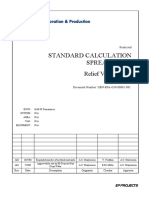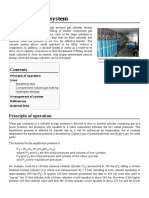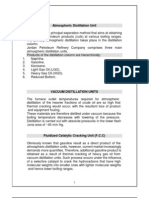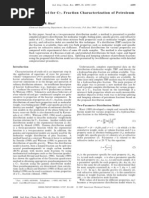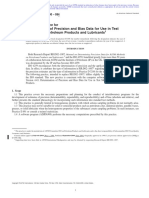Simulation of A Reciprocating Compressor in Hysys
Uploaded by
DefenceDogSimulation of A Reciprocating Compressor in Hysys
Uploaded by
DefenceDogSimulation of a Reciprocating Compressor in HYSYS
The standard compressor model in HYSYS requires that suction pressure, discharge pressure and
flowrate be specified or calculated from elsewhere in the flowsheet. However, if you have
reciprocating compressor curves which provide a relationship between flowrate and pressure,
then how can these curves be used in a HYSYS model?
This figure is an example of reciprocating compressor curves – providing the relationship between
capacity (MMSCFD) and suction pressure (psig) at three discharge pressures.
First it is noted that HYSYS does provide some advanced capabilities in the compressor model:
Ability to add centrifugal compressor curve information – it is possible to add multiple curves
relating head to actual volume flow for different speeds. However, this method is not well-suited
to the format of the reciprocating curves shown here.
Reciprocating Compressor mode –this option provides the ability to specify details for the
compressor – cylinder dimensions, bore, stroke, clearance volumes, etc. If this detailed
information is available, then the option could be useful. However, even if that information is
© C opyright 2017 P rocess Ecology Inc. All rights reserved 1 Page 1
available, it can be difficult to replicate even the simple relationship shown in the graph.
One of the difficulties is the requirement to properly set the pockets when the compressor is
horsepower limited. The reciprocating compressor functionality does not automatically set pocket
position to meet the horsepower.
Our recommendation then is to use the powerful spreadsheet capability in HYSYS which allows the
use of these reciprocating curves.
We would like to have HYSYS calculate the capacity (flowrate) assuming that the suction and
discharge pressures are known. In refrigerated gas plants, it is common for suction pressure to
be controlled, while the discharge pressure is known (i.e., the backpressure to the plant).
First we set up the HYSYS case – this particular compressor is a two-stage compressor, so the
PFD appears as follows:
The suction drums and inter/after stage coolers are also included in the model. We specify the
suction and discharge pressures/temperatures, but leave the flowrate to be calculated by the
spreadsheet.
Next we create the spreadsheet and add the curve data. We assume that the relationship
between capacity and suction pressure can be expressed as two linear segments which is quite
reasonable in this case. The first segment at lower pressure represents the capacity increase in
the region where the compressor is not horsepower limited. The second segment at higher
pressures has a smaller slope (i.e., the flowrate does not increase as quickly with suction
pressure) – this is the region where the compressor is horsepower limited. It is possible to see
more complexity in these curves – for example, if a cylinder changes from double-acting to single-
acting we can see a discontinuity, but many reciprocating compressors can be well-represented
with this simple linear relationship.
The data is shown below:
We have three suction pressure-capacity data pairs for each of the three discharge pressures to
represent the endpoints of each linear segment. Here all three discharge pressure curves have
the same suction pressures (100, 120 and 140 psig), but this doesn’t necessarily need to be the
case.
Now we need to import the suction and discharge pressures, and interpolate and/or extrapolate
the capacity from this data.
© C opyright 2017 P rocess Ecology Inc. All rights reserved 2 Page 2
The calculations are summarized here:
The Suction pressure has been imported to cell B13
The Discharge pressure has been imported to cell B14
In row 18, the capacity at 1000 psig for the imported suction pressure is calculated (either
interpolated or extrapolated). The same is done in row 19 for 1400 psig and in row 20 for
1600 psig. It is possible to do the calculation for each row in one cell, but this would require
four nested IF statements which would be quite unreadable and impossible to troubleshoot.
Thus four statements were created depending on where the suction pressure fit into the
compressor curve range. For example, the formula in cell B18 is:
@if(B13<=B9,C9-(B9-B13)/(B10-B9)*(C10-C9),0)
That is, if the suction pressure is lower than or equal to the lowest given suction pressure, the
capacity is estimated based on a linear extrapolation of the low pressure section of the curve.
Similar functions are provided in columns C, D and E, then column F simply sums the
capacities in the row (only one will be non-zero).
In row 22, the interpolation / extrapolation is now done on discharge pressure, yielding the
calculated capacity in cell F22.
Given the complexity of the formulas, it is not practical to summarize all of them here.
However, you may download the attached HYSYS case which may be used as a template.
The contents of cell F22 are exported to stream “Suction”.
Lastly, the interstage pressure is estimated – assuming the same compression ratio
(PDISCHARGE / PSUCTION) for each stage. This is calculated in cell E13, and exported to stream
“AC1”.
Now, as suction and/or discharge pressures change, the flowrate in the compressor will also
change. The calculated HYSYS flowsheet is shown below:
Do you have questions or comments regarding this article? Click here to contact us.
© C opyright 2017 P rocess Ecology Inc. All rights reserved 3 Page 3
You might also like
- Chhattisgarh State Legal Services Athority Internship Report100% (2)Chhattisgarh State Legal Services Athority Internship Report14 pages
- Schlumberger Exam For Safety Engineer and Answer100% (2)Schlumberger Exam For Safety Engineer and Answer26 pages
- GEN EPA G10 00001 001 A02 Standard - Calculation - Spreadsheet - Relief - Valve - SizingNo ratings yetGEN EPA G10 00001 001 A02 Standard - Calculation - Spreadsheet - Relief - Valve - Sizing9 pages
- PROCESS SAFETY&Mdash 1 - Gas Conditioning Failures Show Need For Design Scrutiny - Oil & Gas JournalNo ratings yetPROCESS SAFETY&Mdash 1 - Gas Conditioning Failures Show Need For Design Scrutiny - Oil & Gas Journal6 pages
- 37 - 4 - Washington DC - 08-92 - 1855 PDFNo ratings yet37 - 4 - Washington DC - 08-92 - 1855 PDF9 pages
- Retrofits Applications Worth ConsideringNo ratings yetRetrofits Applications Worth Considering7 pages
- Cascade Filling System: Principle of Operation UsesNo ratings yetCascade Filling System: Principle of Operation Uses3 pages
- The Boudouard Reaction: C + CO2 2 CO: Thermodynamic Calculations Kj/mole T (C) T (K) LN (KR) KR KR KR Xco2 Xco GRNo ratings yetThe Boudouard Reaction: C + CO2 2 CO: Thermodynamic Calculations Kj/mole T (C) T (K) LN (KR) KR KR KR Xco2 Xco GR6 pages
- Sulfur Recovery From Acid Gas Using The Claus ProcNo ratings yetSulfur Recovery From Acid Gas Using The Claus Proc11 pages
- Valve Response Truth or Consequences by Gregory McMillan and Pierce Wu PDFNo ratings yetValve Response Truth or Consequences by Gregory McMillan and Pierce Wu PDF13 pages
- Droplet Entrainment of Breakup by Shear Flow100% (1)Droplet Entrainment of Breakup by Shear Flow56 pages
- A Systemic Optimization Approach For The Design of Natural Gas Dehydration PlantNo ratings yetA Systemic Optimization Approach For The Design of Natural Gas Dehydration Plant9 pages
- Components of The Glycol Circulating SystemNo ratings yetComponents of The Glycol Circulating System3 pages
- Flare Gas Recovery Using Ejector-A Review: December 2012No ratings yetFlare Gas Recovery Using Ejector-A Review: December 20129 pages
- Gas Blowby - An Overview - ScienceDirect TopicsNo ratings yetGas Blowby - An Overview - ScienceDirect Topics15 pages
- Sump With Weir and Themosyphone Reboiler Modeling ApproachNo ratings yetSump With Weir and Themosyphone Reboiler Modeling Approach7 pages
- Condenser Hot Vapor Bypass Control: PetrocontrolNo ratings yetCondenser Hot Vapor Bypass Control: Petrocontrol6 pages
- A Continuous Model For C7+ Fraction CharacterizationNo ratings yetA Continuous Model For C7+ Fraction Characterization9 pages
- Pressure Transmitter SPTW-P10R-G14-A-M12: Data SheetNo ratings yetPressure Transmitter SPTW-P10R-G14-A-M12: Data Sheet2 pages
- Low Temperature Methane Gas Water Content - Campbell Tip of The MonthNo ratings yetLow Temperature Methane Gas Water Content - Campbell Tip of The Month4 pages
- Condensation Control - The Main Task of Low-Temperature Insulation100% (1)Condensation Control - The Main Task of Low-Temperature Insulation5 pages
- Understanding Surge: Figure 1: Examining The Characteristic Curve100% (1)Understanding Surge: Figure 1: Examining The Characteristic Curve5 pages
- Petroleum Refinery Engineering (CHL 794) Department of Chemical Engineering, Iitd Tutorial Sheet - 4No ratings yetPetroleum Refinery Engineering (CHL 794) Department of Chemical Engineering, Iitd Tutorial Sheet - 415 pages
- Boiler Load Control - Header Pressure or Steam FlowNo ratings yetBoiler Load Control - Header Pressure or Steam Flow2 pages
- Simulation Reciprocating Compressor in HYSYS100% (1)Simulation Reciprocating Compressor in HYSYS4 pages
- Selection of Screw Compressors For Energy Efficient OperationNo ratings yetSelection of Screw Compressors For Energy Efficient Operation8 pages
- Solving Pressure Relief Valve and Piping Capacity Problems Rev 1100% (2)Solving Pressure Relief Valve and Piping Capacity Problems Rev 121 pages
- A Controversial Role Model For Pakistani WomenA Controversial Role Model For Pakistani WomenNo ratings yetA Controversial Role Model For Pakistani WomenA Controversial Role Model For Pakistani Women18 pages
- Engineers Beware - API Vs Asme Relief Valve Orifice SizeNo ratings yetEngineers Beware - API Vs Asme Relief Valve Orifice Size2 pages
- Required Vs Rated Flow For Pressure Drop CalculationsNo ratings yetRequired Vs Rated Flow For Pressure Drop Calculations2 pages
- Driskell - Select The Right Control ValveNo ratings yetDriskell - Select The Right Control Valve5 pages
- Handling Precautions While Installing ButterFly ValveNo ratings yetHandling Precautions While Installing ButterFly Valve10 pages
- Air Coolers Versus Shell-And-tube Water Coolers67% (3)Air Coolers Versus Shell-And-tube Water Coolers8 pages
- Determination of Precision and Bias Data For Use in Test Methods For Petroleum Products and LubricantsNo ratings yetDetermination of Precision and Bias Data For Use in Test Methods For Petroleum Products and Lubricants34 pages
- Ta12.Cau Hoi Trac Nghiem Chuyen de Ngu Phap_vinh BaNo ratings yetTa12.Cau Hoi Trac Nghiem Chuyen de Ngu Phap_vinh Ba201 pages
- 22CS 1st Semester Tabulation Sheet May 2023No ratings yet22CS 1st Semester Tabulation Sheet May 202312 pages
- The Lord of The Harvest's Plan of World Evangelism100% (1)The Lord of The Harvest's Plan of World Evangelism5 pages
- Download Laura Ingalls Wilder 1st Edition Amy Sickels ebook All Chapters PDF100% (3)Download Laura Ingalls Wilder 1st Edition Amy Sickels ebook All Chapters PDF81 pages
- International Conference On Current Research Trends in Engineering, Science & Management (Iccrtesm-2021)No ratings yetInternational Conference On Current Research Trends in Engineering, Science & Management (Iccrtesm-2021)2 pages
- From Experiential Dressing of Senegalese Wrestling Galas To Emotional Consumption of SpectatorsNo ratings yetFrom Experiential Dressing of Senegalese Wrestling Galas To Emotional Consumption of Spectators14 pages
- Developing Teamwork and Communication Skills in A MultidisciplinNo ratings yetDeveloping Teamwork and Communication Skills in A Multidisciplin4 pages
- Simple Past Tense Grammar Drills Grammar Guides - 1928No ratings yetSimple Past Tense Grammar Drills Grammar Guides - 192810 pages
- Net-Analyser Na96 and Na96+: General InformationNo ratings yetNet-Analyser Na96 and Na96+: General Information31 pages
- Functions and Anatomy of Human Body GK Notes in PDFNo ratings yetFunctions and Anatomy of Human Body GK Notes in PDF14 pages
- Care of The Mother, Child and Adolescent (Well Client) Related Learning ExperienceNo ratings yetCare of The Mother, Child and Adolescent (Well Client) Related Learning Experience7 pages
- Auditing Operating Systems Networks: Security Part 1: andNo ratings yetAuditing Operating Systems Networks: Security Part 1: and24 pages






